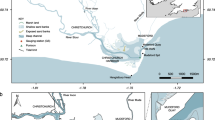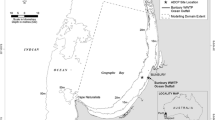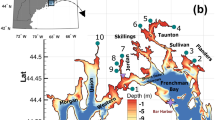Abstract
The establishment of numeric nutrient criteria for the Great Bay Estuary System (GBES) to improve water quality used a computer modeling approach to determine how much of the waste water treatment facility (WWTF) discharges were responsible for nitrogen entering GBES. The Great Bay Estuary, located in southeastern New Hampshire, is a relatively shallow (a tidal amplitude to mean depth ratio of 0.18), well-mixed tidal estuary with a wet area of \(24\,\mathrm{km}^{2}\) and a main channel length of approximately 26 km. The dominant tide is the principal lunar (M2). The modeling approach includes both a finite element, two-dimensional, vertically averaged, time stepping circulation model, and a Lagrangian particle tracking module. The spatial discretization uses finite element triangles with a characteristic length (\(\surd 2A\) where A is the triangle area) of roughly 3 m in the estuary. The time discretization uses a time step of 99.36 s. The particle model does not include vertical motion, and the particles are neutrally buoyant passive particles. Several WWTF discharges were selected and run separately as a continuous release of conservative particles. The percentages of particles residing in each region at the end of the simulation time (65 days) from each source were summarized to allow comparison. In addition, the percentage of particles scaled by the total nitrogen load from all WWTFs was also summarized for each region. It was thus possible to assess the relative contribution of each of the selected WWTF modeled made to each region.








Similar content being viewed by others
References
Bilgili A, Proehl JP, Lynch DR, Smith K, Swif MR (2005) Estuary–ocean exchange and tidal mixing in a Gulf of Maine Estuary: a Lagrangian modeling study. Estuar Coast Shelf Sci 65(4):607–624. doi:10.1016/j.ecss.2005.06.027
Bilgili A, Smith KW, Lynch DR (2005) BatTri: a 2-D unstructured grid generator for finite element circulation modeling. Comput Geosci 35(5):632–642. doi:10.1016/j.cageo.2005.09.007
Bilgili A, Swanson C, Cohn N, Lynch D (2011a) Long term simulations of the transport and fate of the Portsmouth and Newington Wastewater Treatment Facility discharges into The Great Bay Estuarine System. ASA Project 2010-233. Applied Science Associates, Inc., South Kingstown
Bilgili A, Swanson C, Cohn N, Lynch D (2011b) Long term simulations of the transport and fate of the Kittery Wastewater Treatment Facility discharge into The Great Bay Estuarine System. ASA Project 2011-150. Applied Science Associates, Inc., South Kingstown
Bilgili A, Swanson C, Cohn N, Lynch D (2012) Long term simulations of the transport and fate of the South Berwick Wastewater Treatment Facility discharge into The Great Bay Estuarine System. ASA Project 2011-210. Applied Science Associates, Inc., South Kingstown
Ertürk SN, Bilgili A, Swift MR, Brown WS, Çelikkol B, Ip JTC, Lynch DR (2002) Simulation of the Great Bay Estuarine System tides with tidal flats wetting and drying. J Geophys Res Oceans 107(C5):29. doi:10.1029/2001JC000883
Ip JT, Lynch DR, Friedrichs CT (1998) Simulation of estuarine flooding and dewatering with application to Great Bay, New Hampshire. Estuar Coast Shelf Sci 47:119–141
McLaughlin JM, Bilgili A, Lynch DR (2003) Dynamical simulation of the Great Bay Estuarine System tides with special emphasis on N2 and S2 tidal components. Estuar Coast Shelf Sci 57(1–2):283–296
PREP (2009) State of the estuaries 2009. Piscataqua Region Estuaries Partnership, University of New Hampshire, Durham. http://www.prep.unh.edu/resources/pdf/2009_state_of_the-prep-09.pdf. Accessed 17 June 2014
Reichard RP, Celikkol B (1978) Application of a finite element hydrodynamic model to the Great Bay Estuary System, New Hampshire, USA. In: Nihoul JCJ (ed) Hydrodynamics of Estuaries and Fjords, Elsevier Scientific Publishing Co., Amsterdam, Netherlands, pp 349–372
Swenson E, Brown WS, Trask R (1977) Great Bay Estuarine Field Program 1975 Data Report Part 1: currents and sea levels. UNH Sea Grant Technical Report # UNH-SG-157, University of New Hampshire, Durham
Swift MR, Brown WS (1983) Distribution of bottom stress and tidal energy dissipation in a well-mixed estuary. Estuar Coast Shelf Sci 17:297–317
Trowbridge P (2009a) 2009 Environmental indicators report. Piscataqua Region Estuaries Partnership
Trowbridge P (2009b) Numeric nutrient criteria for the Great Bay Estuary, State of New Hampshire. Document R-WD09-12. Department of Environmental Services, Concord
Trowbridge P (2010) Methods for approximating a continuous release from an outfall using the Great Bay particle tracking model. New Hampshire Department of Environmental Services
Author information
Authors and Affiliations
Corresponding author
Rights and permissions
About this article
Cite this article
Swanson, C., Bilgili, A. & Lynch, D. Long-Term Simulations of Wastewater Treatment Facility Discharges into the Great Bay Estuarine System (New Hampshire). Water Qual Expo Health 7, 67–77 (2015). https://doi.org/10.1007/s12403-014-0132-8
Received:
Revised:
Accepted:
Published:
Issue Date:
DOI: https://doi.org/10.1007/s12403-014-0132-8




